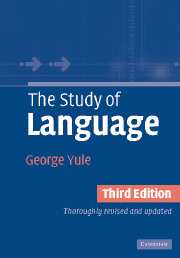Book contents
- Frontmatter
- Contents
- Preface
- The origins of language
- Animals and human language
- The development of writing
- The sounds of language
- The sound patterns of language
- Words and word-formation processes
- Morphology
- Phrases and sentences : grammar
- Syntax
- Semantics
- Pragmatics
- Discourse analysis
- Language and the brain
- First language acquisition
- Second language acquisition/learning
- Gestures and sign languages
- Language history and change
- Language and regional variation
- Language and social variation
- Language and culture
- Appendix: Suggested answers to study questions
- Glossary
- References
- Index
Language and regional variation
- Frontmatter
- Contents
- Preface
- The origins of language
- Animals and human language
- The development of writing
- The sounds of language
- The sound patterns of language
- Words and word-formation processes
- Morphology
- Phrases and sentences : grammar
- Syntax
- Semantics
- Pragmatics
- Discourse analysis
- Language and the brain
- First language acquisition
- Second language acquisition/learning
- Gestures and sign languages
- Language history and change
- Language and regional variation
- Language and social variation
- Language and culture
- Appendix: Suggested answers to study questions
- Glossary
- References
- Index
Summary
Yesterday, I toll my dad, “Buy chocolate kine now, bumbye somebody going egg our house you know, cuz you so chang.” He sed, “Sucking kine mo' bettah cuz lass mo' long. Da kids going appreciate cuz …” And befo' he could start his “Back in my days story” I jus sed, “Yeah, yeah, yeah, I undahstand,” cuz I nevah like hea da story again ah about how he nevah have candy wen he wuz small and how wuz one TREAT fo' eat da orange peel wit sugar on top. Da orange PEEL you know. Not da actual orange, but da orange PEEL. Strong emphasis on PEEL cuz dey wuz POOR.
Tonouchi (2001)Throughout this book, we have been talking about languages such as English, Spanish or Swahili as if there was a single variety of each in everyday use. That is, we have largely ignored the fact that every language has a lot of variation, especially in the way it is spoken. If we just look at English, we find widespread variation in the way it is spoken in different countries such as Australia, Britain and the USA. We can also find a range of varieties in different parts of those countries, with Lee Tonouchi's account of ‘Trick-O-Treat’ in Hawai'i as just one example. In this chapter, we investigate aspects of language variation based on where that language is used, as a way of doing linguistic geography.
- Type
- Chapter
- Information
- The Study of Language , pp. 194 - 204Publisher: Cambridge University PressPrint publication year: 2005



